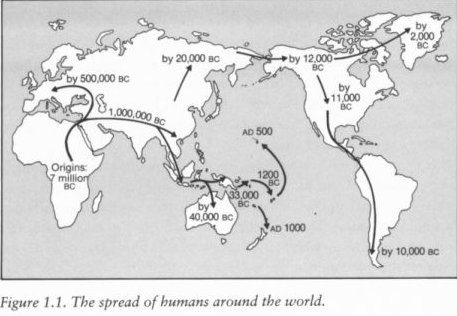
 |
Guns, Germs, and Steel
|
Please go to the new Coffee Coaster site implemented more gracefully in Wordpress. Full conversion by 9/12. This page: http://brianrwright.com/CoffeeCoasterBlog/?p=858 |
Warning to the former field of Republican candidates for president, several of whom believe in Divine Creation: Jared Diamond's bestselling book
on historical anthropology spends no time questioning the theory of evolution. Indeed, as most scientists in his field(s)—Dr. Diamond is difficult to classify, but from my first reading his book, I'd call him a natural scientist with a prime interest in anthropological sociology—he simply assumes it and marches on his merry way. Mike Huckleberry, eat your heart out!
Guns, Germs, and Steel is an utterly fascinating
revelation of those human origins you always kinda sorta knew but never pinned down. Well, Jared Diamond nails them with a fluid writing style that makes you want to turn the pages to discover the next key BIG THAWT behind this historical development or that one. For example, how did 168 Spanish soldiers in 1532 with a handful of horses, muskets and spears in unfamiliar territory—the nearest Spanish settlement was 1,000 miles away (in Panama)—under Francisco Pizarro manage to conquer the Peruvian Incans, the most advanced civilization in the New World with 80,000 dedicated soldiers?
Answer: Treachery and [inducement of] fear.
Then the bigger immediate question is how did the Europeans (or Eurasians—Diamond collects modern Europe and SW Asia into one vast domain—) manage to subdue the entire North American continent full of as many as 20 million indigenous people. The largest toll inflicted on the American Indian populations was from disease—to which the Europeans had developed immunities and for which the Indians had no such protection. (One estimate is that up to 95% of the native populations were destroyed by European diseases, rather than force of arms.)
It turns out disease and immunity are related to the domestication of animals; there's a whole chapter on why microbes developed and transitioned from animals in close proximity with dense human populations.
###The book starts with a migration lesson, from the origins of homo sapiens in Africa roughly 7 million BC, and proceeding to the "starting point" of the narrative: 11,000 BC, "which corresponds approximately to the beginnings of village life in a few parts of the world, the first undisputed peopling of the Americas, the end of the Pleistocene Era and the last Ice Age, and the start of what geologists call the Recent Era."

Plant and animal domestication began in at least one part of the world—the so-called Fertile Crescent, i.e. Mesopotamia (Iraq), now home to dispersed tons of the American government's depleted uranium that will be indiscriminately irradiating the countryside and remaining humans for several million years to come (sorry, couldn't resist throwing that rarely appreciated factoid in there)—within 1,000 years of the above date. Then Dr. Diamond walks through the movements of peoples on all the continents.
Interestingly, the building of a robust social system that can spread to dominate or displace other social systems depends originally on "farmer power," access to sufficient numbers of species of domesticable flora and fauna in a real-estate configuration that supports greater human densities and enables time for creation of writing. I'm simplifying. Indeed, just when you think you have it figured out why one ethnic grouping should have prevailed over another, the author pulls out the rug with a subtlety. For example, based on agriculture, tools, and development of writing, one would have expected China to become dominant over Europe. What happened?
His answer here is precisely because China had established great uniformity of expression in language (and thought?) (which brought advances that were far ahead of Europe or even the Islamic world until about 1450 AD). But then as technology grew further, the value of uniformity in language declined: it entailed too much conformity in action. Europe, being more fragmented, tended to produce more, less-uniform solutions to technical issues; the best solution became quickly apparent. Instead, say, when part of China abandoned oceangoing vessels—I presume the decision came from a central government of some kind—all of China went along.
The idealists among us might wonder, if one civilization is so much more advanced than another, why couldn't that advanced civilization "live and let live?" Why did the Europeans have to basically embark on a policy of extermination of the indigenous people in America, why did they have to do the same thing in Australia, and so on. The author cites other instances, for instance, the Maori of Polynesia simply wiped out or enslaved another tribe, the Moriori, who must have been the "give-peace-a-chance" hippies of the 1830s. That sort of question appears to be out of scope for Diamond, and I feel he could have at least commented on it.
The basic thesis of Guns, Germs, and Steel can be summarized as follows:
"History followed different courses for different peoples because of differences among people's environments, not because of biological differences among peoples themselves." — page 24
Fair enough, I can see the Reformation, the Enlightenment, the Declaration of Independence, the Constitution, and the Bill of Rights, etc.—and the ideas that underlie these political achievements—as completely within the capability of any racial or facial makeup. European white society was handed the ball by external factors that led to the technological civilization we see today—a system that shall rise or fall depending on whether the framework of society is consistent with concept formation, psychological independence, and critical thinking. Reaching the threshold was archaeologically ethnicity-blind to be sure, but where we go from here is dependent on self-awareness of this threshold.
I feel Diamond does not properly attend to the above political achievements, nor to the concept of individual rights within the framework of large communities with common understanding. The effectiveness of the Founding Fathers' invention of liberty within community, especially with the federal concept, is staggeringly relevant to guns, germs, and steel... not to mention production, trade, peace, and benevolence. Further, I don't see any appreciation of a volitional ethical system, such as Objectivism, that encourages the individual to use his/her conceptual faculty.
I so want to send to Diamond the Introduction to Objectivist
Epistemology and even the mainly value-free writing of a futurist/ transhumanist like Ray Kurzweil (The Singularity is Near). After all, the main reason for knowing where we came from is to better understand where we want to go. Dr. Diamond illuminates our origins with zest and clarity.
###
###
 |
 |
|||
| New Pilgrim Chronicles Forum |